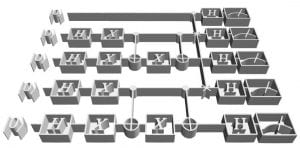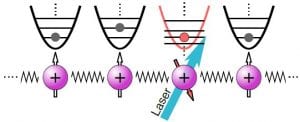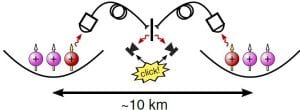Thanks to their unmatched coherence properties, and long-range coupling via the Coulomb interaction, trapped atomic ions have become a versatile experimental platform with a variety of scientific and technological applications. We are currently pursuing three different research directions based on trapped-ion experiments:
Quantum Algorithms
Using the electronic states of single trapped Ytterbium ions as qubits, we realize a universal quantum computer. Quantum gates are generated by an array of laser beams that individually address each ion to create entanglement via the shared motional modes in the trap. The experiment was originally established in the group of Prof Chris Monroe. We are continuing to work with collaborators from different institutions to realize quantum information applications using circuit-model quantum computation in this system. Additionally, we are extending the power of near term quantum computers by using one of the biggest advances in classical computing technology: machine-learning. We are employing machine learning techniques for quantum-classical hybrid optimization algorithms as well as for the development and calibration of new quantum gates, and the characterization of complex quantum systems.

Simulation of Quantum Phenomena
The high degree of control over individual quantum systems achievable with individually trapped ions can be used to study an array of new physical phenomena. Rather than creating a quantum circuit, the Hamiltonian evolution of interest can be either created directly or closely approximated by tailored couplings between the internal and motional states of trapped ions. We are investigating phonon-polariton states (excitations of the coupled spin-motional system), Hubbard model simulations with local phonons (in analogy to electrons hopping from atom to atom in a solid, phonons can be made to hop from ion to ion in a trap), and the creation of para-particle dynamics (these unusual particles, which are the excitations of deformed harmonic oscillators, have been studied since the early days of quantum mechanics, and are believed to not occur in nature).

Medium-distance Quantum Networking
Classical computers only realize their full potential when connected in a network. Similarly, the next frontier in quantum information is the creation of quantum networks with applications in quantum cryptography, tests of non-locality, state teleportation, quantum sensing and distributed quantum computing. The elementary nodes of such a network are matter qubits with good coherence properties such as trapped ions that are coupled to photon modes which carry the information over large distances. To this end, we are currently constructing a new experimental apparatus to trap Strontium ions. This atomic species has a transition in the infrared that can generate single photons which are entangled with the state of the emitting ion. These can be transmitted over several miles of optical fiber and can form the basis for a city-size quantum network.

